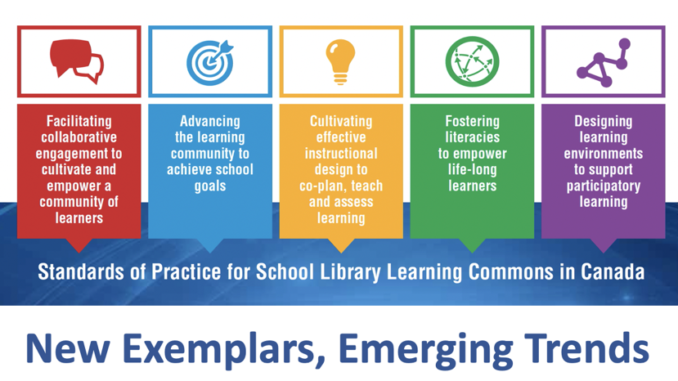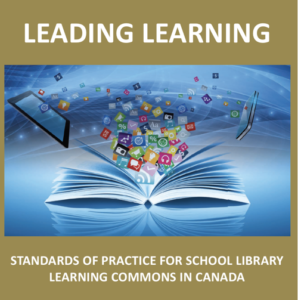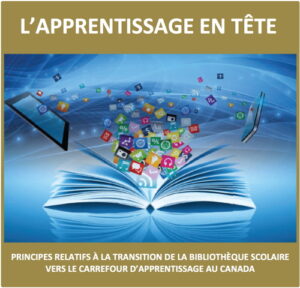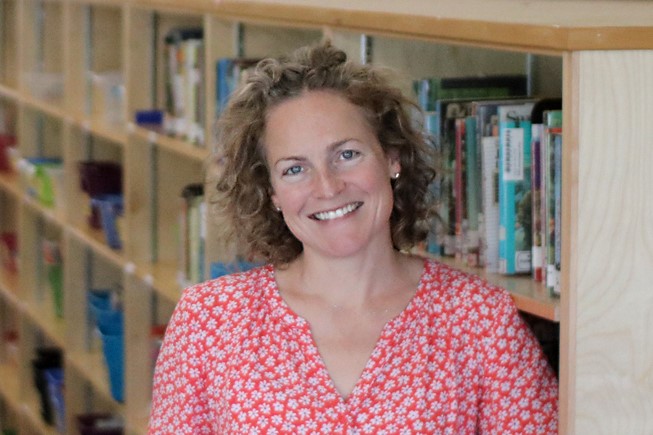
By Judith Sykes and Lila Armstrong
Will the COVID-19 pandemic forever change school libraries?
As documented in the article Future of the School Library Learning Commons in Canadian School Libraries Journal (Freibauer, 2020, November 11), school libraries have been increasingly challenged to survive and thrive throughout the continuing pandemic. New exemplars added to Leading Learning / L’Apprentissage en tête throughout 2020 and winter/spring 2021 illustrate not only school library learning commons (SLLC) survival with thriving adaptations, but also shifting trends in SLLC practice across Canada. Some trends have emerged in response to the pandemic as SLLC support for students and teachers necessitated an increased focus on and development of the virtual SLLC.
Other trends reflect continued growth in diversity awareness and action, and engaging students in making and doing. What trends prevail? They generally fall into six key areas:
- Increasing development of the virtual SLLC and the development of innovative participatory learning opportunities
- Ensuring infusion of digital literacy skills and global competencies
- Continued growth in diversity awareness and action such as collection development with an emphasis on diversity and inclusion
- Attention to wellness for both staff and students
- Expanding the engagement of students in making and doing
- Outreach to the school community to inspire reading and learning
Selected Exemplars in Trending Areas
Note that the exemplars listed for each trend below link to the applicable Leading Learning standard indicator, where you can link directly to the example demonstrating the emerging trend. You will find many other exemplars for the standard as well. Enjoy!
Increasing development of the virtual SLLC and the development of innovative participatory learning opportunities
In this new world SLLC trending has moved from “transitioning into a learning commons” – a majority in the physical spaces – to the emergent shift in transitioning to the virtual SLLC. Co-planning/teaching and engaging students in participatory learning experiences, often a challenge pre-pandemic, becomes more so during pandemic. The following exemplars illustrate practitioners presenting inspiring and innovative ways to meet these challenges.
- Learning Environments: Exemplar B4 Two Ontario teacher-librarians collaborate with others to adapt the virtual essence of the SLLC into a better understanding “of the goals and purpose of a virtual library learning commons and the role it can play during emergency distance learning and beyond” – necessitated more than ever during the 2020 covid pandemic (Brown & Lyons, 2020, June 2).
- Advancing the Learning Community: Exemplar A4 A secondary teacher-librarian in the Surrey, British Columbia shares superb specific and targeted SLLC goals founded on the document Leverage Your LLC: Pandemic Partner for Learning (Canadian School Libraries, 2020, September 7) and the inquiry question “How can schools maintain critical SLLC benefits during pandemic times?” (Gleeson, March 3, 2021).
- Advancing the Learning Community: Exemplar C4 A Surrey, British Columbia teacher-librarian course project “Pandemic Challenges to Collaboration” involves 26 different teacher-librarians facing new challenges during the pandemic in the already challenging process of co-teaching. Challenges are addressed and solutions encouraged (De Anna, 2021, May 12).
- Instructional Design: Exemplar B4 An inspiring collaboration from Ontario documents teacher and students’ learning journey through an outstanding collaborative creative writing unit with a diverse grades 4/5/6 classroom. Includes teacher perspective and growth on collaborating with a teacher-librarian (Campbell & Nock, 2021, May 12).
- Learning Environments: Exemplar B4 Canadian School Libraries Chair/co-editor of CSL Journal Anita Brooks Kirkland shows ways libraries have utilized their virtual spaces to maximize collaboration and participation in the current remote learning environment created by the pandemic (Brooks Kirkland, 2020, June 2).
- Instructional Design: Exemplar G4 An Ontario teacher-librarian outlines a successful journey as pedagogical leader in developing a dynamic participatory library learning commons in the re-development of a secondary school library (King, 2020).
- Advancing the Learning Community: Exemplar C4 The Ontario authors discuss how they applied four aspects of participatory learning in the library learning commons through organizing a program they called 12 Days of Code deliberately addressing active participatory learning by combining literacy and STEM goals (Mulcaster, Pitter-Adlam, Williams & Zita, 2020).
- Collaborative Engagement: Exemplar F3 Librarians at the Toronto District School Board (TDSB) Professional Library, Library Learning Resources and Global Education Department share a timely curated list of current books related to learning and teaching online (Ameline & Chyung, March 3, 2021).
Ensuring infusion of digital literacy skills and global competencies
With the sudden change to hybrid and online learning, students and educators transitioned quickly, while also addressing best practices in the way technology is used in schools. An increasingly important issue for all students and teachers has been learning how to be good digital citizens, staying safe and understanding the impact of our actions online. Appreciating the roles and responsibilities of 21st century learners, and educators, as we expand our use of digital technologies is certainly a trend that will continue to develop.
- Instructional Design: Exemplar B4 The Directors of Research and Education (2021) from the Canadian organization MediaSmarts provide insight into navigating media and online learning during the pandemic crisis and into the future, post-pandemic with links to key media literacy resources for students, teachers, and parents (Brisson-Boivin & Johnson, March 3, 2021).
- Fostering Literacies: Exemplar E4 The founder and CCO of Digital Human Library defines digital citizenship, the importance of teaching it as a way of thinking, and using children’s books as digital citizenship mentor texts (Cassell, March 3, 2021).
- Instructional Design: Exemplar E4 Drawing on technological pedagogical content knowledge (TPACK) and intercultural pedagogies, the founder and CCO of Digital Human Library shares the report and analysis of findings from a survey of 117 videoconferencing educators reporting possibilities and challenges for using videoconferencing, particularly for intercultural experiences (Kruta, Carano, Cassell, Lavoie & Davidson-Taylor, 2020).
- Fostering Literacies: Exemplar C4 An information specialist/teacher-librarian in British Columbia who coordinates the Teacher Librarian Diploma and Certificate Program at UBC, represents Canadian School Libraries (CS) on the Board of Directors and chairs the Canadian Federation of Library Associations / Fédération canadienne des associations de bibliothèques (CFLA-FCAB) Intellectual Freedom Committee, representing Canadian School Libraries shares an innovative co-planned presentation on internet safety for secondary students (Beaudry, 2021, May 12).
Continued growth in diversity awareness and action such as collection development with an emphasis on diversity and inclusion
As related in many previous standard exemplars regarding collection development and SLLC activities, equity and diversity emphasis continues. Diversity auditing – “a thorough review or inventory of items in the LLC, with the goal of determining exactly how diverse the collection is” – or “equity in action” (Rubio, March 3, 2021) becomes a critical process.
- Learning Environments: Exemplar G3 The Coordinator for Libraries and Information Services in SD38 Richmond, British Columbia, defines and outlines processes and steps inherent to a diversity audit of the LLC (Rubio, March 3, 2021).
- Fostering Literacies: Exemplar F2 A K-12 Ontario school curated a Canadian collection with links to Indigenous cultures, the LGBTQ+ communities, social justice, Ramadan, and the Asian communities (Alliston Union Public School, 2020).
- Collaborative Engagement: Exemplar A4 Learn about the ongoing development, accomplishment and possibilities of a virtual library learning commons in action in support of the author’s provincial curriculum (British Columbia) and how successfully it can address diversity in student learning needs (Davies, 2020, June 2).
- Learning Environments: Exemplar C4 An elementary British Columbia teacher-librarian focuses on collection development with aid from a district grant. Student input and need led to selecting sensory/audio resources (Cordeiro Lutz, November 11, 2020).
- Learning Environments: Exemplar G3 A teacher-librarian with the Toronto District School Board outlines experiences created for developing critically conscious citizens focusing on the Truth and Reconciliation Commission of Canada: Calls to Action (Khokhar, 2020).
- Collaborative Engagement: Exemplar E4 A teacher-librarian with the Toronto District School Board reflects on the process of weeding as an equity issue; reflecting that weeding should be systemic, ongoing and responsive. (Khokhar, 2020, November 11).
Attention to Wellness for both staff and students
Initial SLLC responses to pandemic school closures heightened an emergent need to focus on providing immediate and increased virtual access to resources, learning supports and experiences for students and staff including developing wellness initiatives. In a recent article, Canadian School Libraries Chair/co-editor of CSL journal Anita Brooks Kirkland (2021, May 12) addressed student well-being in the SLLC focusing on the critical need to expand our understanding of how to support the well-being of all students in an intentional and holistic way, highlighting the CSL resource Culturally Relevant And Responsive School Library Learning Commons and new Leading Learning theme in the Designing Learning Environments to Support Participatory Learning standard Designing for Student Well Being in the LLC.
- Learning Environments: Exemplar G2 The SLLC in a new secondary school in British Columbia adjusts to meet the needs of staff and students as schools closed due to the covid-19 pandemic. Immediate tasks for the teacher-librarian included providing resources for teachers now teaching online, finding answers to copyright issues associated with open access, and creating systems to provide students with computers and resources (Beaudry, 2020, June 2).
- Fostering Literacies: Exemplar F3 An Ontario teacher-librarian works with various members of Indigenous and non-Indigenous communities to restore the land around their school dedicated to powerful learning during the pandemic (Spence, November 11, 2020).
- Instructional Design: Exemplar C2 An Ontario teacher and teacher-librarian provide a detailed plan and resources for teachers to appropriately and sensitively discuss tragic or bizarre events that the school community, local area, or world has heard about (Borysiak & Harris, March 3, 2021).
- Collaborative Engagement: Exemplar C3 An Ontario teacher-librarian shares examples of collaboration, meaningful interaction, and growth among her board’s Secondary Teacher-librarian Council. Shared efforts promote attention to staff wellness and efficacy (Whittaker, 2021, May 12).
Expanding the engagement of students in making and doing
There are many factors to deal with in expanding student making and doing – virtually as well in returning to the physical SLLC spaces during current times. What curricular projects, activities, materials and resources will the student have at home? What safety measures are needed with making and doing once they return to schools?
- Learning Environments: Exemplar B3 A large K-8 Ontario school provides motivating resources and activities geared to learning during the pandemic (Aylesbury School, 2021).
- Learning Environments: Exemplar B3 An Ontario junior k – grade 8 school’s virtual LLC provides timely information and activities for remote learning, curricular choice boards co-planned with teachers for learning at home, student projects and resources, teacher support resources (John A Leslie Public School, 2020).
- Learning Environments: Exemplar B3 A virtual SLLC in Newfoundland-Labrador supports students with many attributes created by the teacher-librarian for them in the 2020 pandemic such as on-line maker spaces, escape rooms, wellness, virtual field trips and more (Leary’s Brook Junior High School, 2020).
- Instructional Design: Exemplar G4 This innovatively presented year-end report composed by an Ontario teacher-librarian in a secondary school includes an adaptive response to Covid19 (St. Aubyn, 2020).
- Learning Environments: Exemplar E4 A teacher-librarian from Peel School District, Ontario moved from a physical library space to a fully virtual program in the 2020-2021 pandemic school year exploring “the pedagogy and philosophy that anchors the curation of the virtual library learning commons to provide maker prompts, continuing to embed literacy-based inquiry and culturally responsive practices in school wide make prompts and provocations” (Lyons, 2021, May 12).
- Collaborative Engagement: Exemplar E3 A reporter interviews administrators and librarians to write about exciting school library learning commons transformations occurring throughout the English Montreal School Board (EMSB) (Hanes, 2020, January 24).
Outreach to the school community to inspire reading and learning
Inspiring students to read during the pandemic is a key feature on many virtual SLLCs, with recommendations for students, teachers, parent/guardians at home. SLLCs continue promoting student reading through programs such as The Ontario Library Association Forest of Reading program, I Read Canadian Day, and the TD Summer Reading Club (Fortin & Roy, 2021, May 12). Research into summer reading by the co-editors of the Canadian School Libraries Journal presented a wonderful opportunity for Canadian School Libraries (CSL) to investigate whether summer lending programs in Canada’s school libraries could be successful, and if so, what factors would contribute to that success (Brooks Kirkland & Koechlin, 2020).
- Learning Environments: Exemplar B3 A secondary school virtual LLC supports student learning and literacy inspiring reading and supporting research with databases, note taking tools, citation resources, class links to projects with pathfinders and unique resources (R.E. Mountain Secondary School, 2020).
- Fostering Literacies: Exemplar B4 A British Columbia teacher-librarian moved their annual “Battle of the Books” to a digital platform allowing students to learn how to work collaboratively in a digital world while still becoming a community of readers (Armstrong, 2020, June 2).
- Fostering Literacies: Exemplar A4 Sponsored by CSL and led by three expert literacy leaders from Ontario, Read Into This, is a podcast about books, articles, fiction, non-fiction, graphic novels, media texts, cookbooks, and everything in between. The presenters explore with guests how we read and how what we read makes us who we are and helps us learn about those around us (Lyons, Noble & King, 2020).
- Learning Environments: Exemplar B3 Peel District School Board Libraries (Ontario) teacher-librarians and classroom teachers have developed a wonderful collection of learning provocations for home or class learning presented as interactive choice grids (Peel District School Board Libraries, 2020).
- Fostering Literacies: Exemplar G1 An Ontario school supports learning at home with many resources including “Read Alongs” for elementary school students that focus on anti-racism and social justice, Indigenous cultures, and LGBTQ+ communities (Forest Manor Public School, 2020).
Conclusion
Ontario teacher-librarian Freibauer, editor of The Teaching Librarian (Ontario School Library Association magazine) and member of Canadian School Libraries (CSL) Board of Directors and CSL Journal Editorial Board, reached out to several education and library thinkers for their thoughts “through a library lens” regarding UNESCO’s Education in a post-COVID world: Nine ideas for public action (2020). The generous and thought provoking responses (Freibauer, 2021, May 12) reflect trends in SLLC practice as seen in many of our new exemplars as we continue to move through the pandemic – equitable access for all students to knowledge, information,technology, literacy, participatory learning, wellness and safety and valuing teachers and teacher collaboration. The exemplars selected above provide a snapshot into the inspiring and dedicated work thriving in SLLC practice today.
Explore Leading Learning / L’Apprentissage en tête
Leading Learning provides a guide for the transition of school libraries to vibrant centres of teaching and learning responsive to the diverse needs of learners today and into the future. It also serves as a measurement tool to help schools determine where they are now with library facilities and programs and where they want to advance to.
 |  |

Judith Sykes has been a teacher, teacher-librarian, district school library specialist, and elementary school principal for the Calgary Board of Education in Alberta. She was the provincial school library manager for the Alberta Ministry of Education, leading the School Library Services Initiative 2008-2012. Judith was the project coordinator and a contributing writer for Leading Learning: Standards Of Practice For School Library Learning Commons in Canada when it was first published, and continues as co-chair of CSL’s Leading Learning Committee. She also serves on the CSL Board of Directors. Judith has published several books about school library practice, including two that deal specifically with action research approaches.

Lila Armstrong is an elementary teacher-librarian in Campbell River, BC. She brings private, public and international teaching experience to her French Immersion teaching practice. Lila is hooked on school and thrives when learning new things. She is currently learning about farming as her family now resides on a farm in the Comox Valley. Lila is the website editor for Leading Learning / L’Apprentissage en tête.

